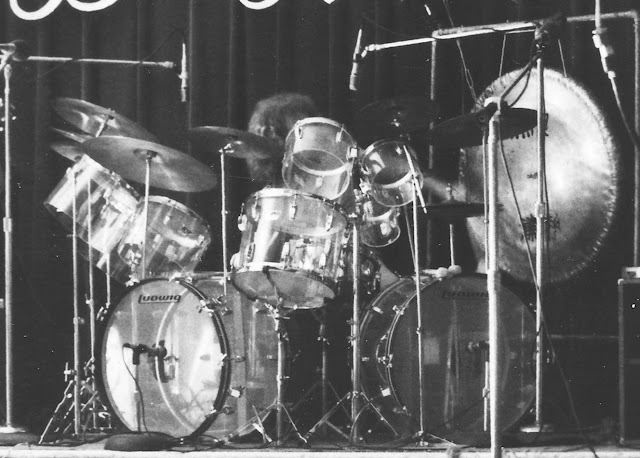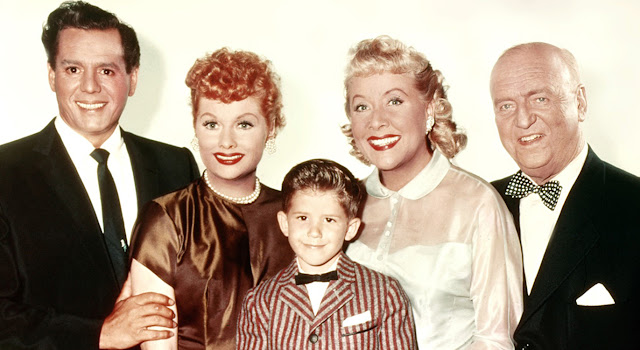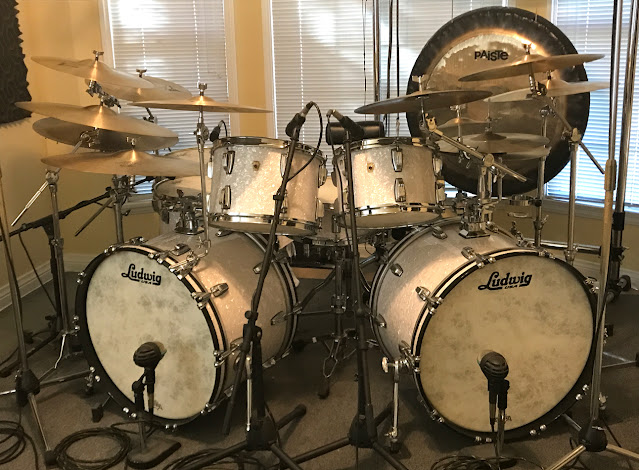My Drumsets, Part 3: Ludwig Vistalite (1973 – 1982)
Third Drumset: Ludwig Vistalite Drums (clear Plexiglas shells); Fibes SFT690 Snare Drum (fiberglass shell)
Note: This drumset was not in my preferred 2 bass drums/2 small toms/2 floor toms/snare drum configuration. At the time I bought it I was influenced by the configuration of the custom-made stainless-steel drumset that Carl Palmer began using with Emerson, Lake and Palmer in 1973.
• Two 24” x 14” bass drums, 6” x 5½", 8” x 6", 10” x 6½",
12” x 8", 13” x 9", 14” x 10" single-head tom-toms, 15” x 12” double-headed small tom, 20” x 18”
floor tom, 14” x 5½” Fibes fiberglass snare drum
• Mostly new Ludwig hardware; some hardware
carried-over from “Expand-O-Kent” drumset
• Cymbals & gong initially carried-over from
“Expand-O-Kent” drumset
When I hit the road with my band Infinite Silence in 1972 the sound of the psychedelic-painted “Expand-O-Kent” drumset (see Part 2 of this series) was overwhelmed on stage by the loud amplification used by the band’s keyboard and bass players. Keyboardist Robert Orellana used two Leslie 147s for his Hammond B3 organ and ran his Mellotron, electric piano and ARP 2600 synthesizer through a 300-watt Ampeg SVT amp with two speaker cabinets that each contained eight 10" speakers. Bass guitarist Bill Hokenson ran his bass through another Ampeg SVT with two 8 x 10 cabinets. (For the first six months we were on the road the band didn't have a guitarist.)
Although Pop had always told me
that Slingerland made the best drums (because of their association with Gene
Krupa), I gravitated towards Ludwig because: 1) Ginger Baker (still my drumming hero) played Ludwig, and 2) just about every other rock drummer I
liked at the time (Mitch Mitchell, John Bonham, Carmine Appice,
and of course, Ringo Starr) also played Ludwig. To top it all off, Ludwig by far had the hippest drum
finishes. With new pearl wraps called “Psychedelic Red”, “Mod Orange”, “Citrus
Mod” and “Gold Silk”, in the early 1970s Ludwig was leaving all the other drum brands in the dust.
Then in 1972 Ludwig completely changed the drum game when they introduced the Vistalite series of drums with shells made not from wood, but from Plexiglas! The Vistalites’ Plexiglas shells were available in clear, or tinted amber, yellow, green, red, or blue. The 'phantom' look of the clear Vistalites absolutely knocked me out; I just had to get a set. (A 1976 photo of my Vistalite drumset appears at the top of this post.)
Sound quality, aside from more volume, was a secondary consideration except for the snare drum, which is why I got the Fibes fiberglass snare instead of a matching clear Vistalite snare. The Vistalite snares sounded like toys, with way too much “boing” in their sound, while the Fibes model was an amazing instrument with full, dry tone, sensitive response and absolute knock-you-down power.
I used the Vistalite drumset the entire time I played drums professionally during our band's evolution from Infinite Silence (1973) into Pulse (1974 – 75) and finally into Revolver (1975 – 77), and it served my needs in all of them extremely well. The two bass drums, snare drum, double-headed small tom and floor tom formed a 4-piece "standard" drumset (plus the extra bass drum), and the six single-headed tom-toms provided tons of extra melodic opportunities and a good tonal contrast from the double-headed drums. Plus, the Vistalite drumset sounded quite good, with powerful projection and a strong fundamental tone; it looked sexy as hell (especially under stage lights) and it was durable to a fault. My only regret about it was letting the drum store owner talk me out of the 26" x 14" bass drums I originally wanted ("They'll be too difficult to control") and into ordering 24" x 14" bass drums instead. The first time I sat down to play my new drumset I realized that I should've stuck to my guns and ordered the 26" bass drums, since the 24s just didn't deliver the sound I was after. (I made another vow that from then on I would always trust my own instincts when it came to my drum gear.)
Added in 1974:
• 1½-octave set of brass chimes
I lucked upon a 1½-octave set of brass chimes that had come out of a dismantled church organ and were on their way to a metal scrapyard. I built a stand for them out of plumbing pipes, but each of the 18 chime tubes had to be individually hung and removed each time the band’s gear was set up and torn down, which was a huge pain in the ass for the roadies. (They quickly grew to hate the chimes, and I can’t say that I blame them.) Another problem was that these chime tubes lacked the bulging striker caps that make conventional orchestral chimes easy to play — you simply hit the cap at the top of the chime tube with a rawhide chime mallet to get the proper sound. When these chimes were a part of the organ each chime tube had an electrical solenoid that always struck the tube in the exact right spot on the side at the very top. So when playing the chimes with a rawhide chime mallet I had to strike each tube very accurately on the side at the top to get the proper sound out of it; even a slight miss would result in a ‘clank’.
The final nail in the chimes’ coffin was that there were only two or three spots in our entire four-hour show where I could fit them in (the middle of Yes’s “Roundabout”, during The Who’s “The Punk Meets the Godfather” and one or two other songs that I can’t even recall now). I finally gave up on them after a year or so. The roadies were sincere in their thanks (and relief) when I told them they would no longer have to deal with them. They eventually wound up at a metal scrap yard, which is where they had been headed when I intercepted them from the church.
In 1974 Pulse added guitarist Paul Stevens, who used a 100-watt Marshall amplifier (one of the loudest guitar amps made at that — or any other — time) and I began to hit so hard in order to hear myself that I started breaking cymbals. I finally insisted that the drums be mic'd through the P.A. system at every gig and the broken-cymbal problem disappeared, but not before I had gone through two 18” crashes, a 20” crash and a pair of 14” hi-hats! That was the only time in my drumming life that I ever broke a cymbal. I replaced the broken crashes with heavier models that stood up to stronger playing, got a pair of 16" hi-hat cymbals that simply roared, and I traded in my 20" Medium Ride on a new 21" Rock ride that was specifically designed to cut through on louder stages (and it did!).
My cymbal setup continually evolved the entire time I was on the road playing professionally (in fact, my cymbal setup has been in constant evolution from the time I bought my first drumset from Terry in 1965 all the way up through the present day) and in Revolver during 1975 – 1977 I was using the following all-Zildjian cymbal setup:
• 21" Rock 21 Ride
• 20" Swish
• Two 18" Medium-Thin Crashes
• 16" Medium-Thin Crash
• 14" Medium Crash (converted hi-hat cymbal)
• 13" Extra-Thin Crash (1940s-vintage)
• 13" Hi-Hats (1940s-vintage — the 16" hats were just too damn slow)
• 6" Paper-Thin Splash
Early in 1977 Revolver spent a couple of days in a recording studio in St. Paul recording demo versions of a half-dozen original songs. As the roadies were taking the gong back to the truck after we had finished, the building’s elevator broke down. Although the roadies were able to exit the elevator through a small escape hatch in the ceiling, the 3' x 3' gong case wouldn’t fit and had to be left behind. I arranged with the building's manager to meet him there at 10am the following morning when he was to fix the elevator, but he showed up much earlier, fixed the elevator, removed the gong and set it in the building’s hallway, all without letting me know. When I got there at 10am the gong was nowhere to be found and the building manager claimed he didn’t know where it was and hadn’t seen who might have taken it. Although I didn't think of it that way at the time, this incident proved to be a harbinger of things to come for me as I struggled to continue being A Drummer.
After quitting the band and moving back to L.A. in 1977 I kept this drumset set up in the three homes that my first wife and I rented together between 1978 and 1982, but I was in the midst of the major life change I had begun when I quit being a professional musician and decided to become a 'productive member of society'. When my wife and I bought a condominium and moved into it late in 1982 I sold the Vistalite drumset and all my other drum equipment, except for the 1940s-vintage 13” Zildjian Crash cymbal, which I still own to this day. I had left myself completely drumless for the first time in 18 years. At that time in my life this seemed like the right thing to do — I had very rarely played the drums during the five years since I had quit playing professionally. But a couple of years later I realized just how serious an error it was for me to no longer be A Drummer.
-Hyam R. Sosnow









Comments
Post a Comment